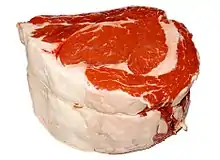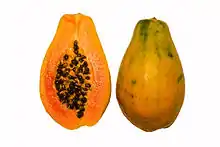Flesh
Flesh is a term for some soft tissues of an organism. Various multicellular organisms have soft tissues that may be called "flesh". In mammals, including humans, "flesh" covers muscle tissues and fat, but not for example brain tissue. In a culinary context animal (and occasionally plant) flesh is called meat.
In particular animal groups such as vertebrates, molluscs, and arthropods, the flesh is distinguished from non-fleshy body structures such as bone, shell, and exoskeleton, respectively.[1] In plants, the flesh is the soft tissue that comprises structures such as edible fruits, as opposed to tough structures like non-fleshy fruits and wood. In fungi, "flesh" refers to trama, the soft, inner portion of a mushroom, or fruit body.[2]
A more restrictive usage may be found in some contexts, such as the visual arts, where "flesh" may refer only to visible human skin, as opposed to parts of the body covered by clothing and hair. "Flesh" as a descriptor for colour usually refers to the pinkish/paler skin colour of Caucasian humans.
Gallery
 Cow flesh (beef)
Cow flesh (beef) Flesh of a papaya fruit
Flesh of a papaya fruit Cut mushroom (Neoboletus luridiformis) revealing blue flesh
Cut mushroom (Neoboletus luridiformis) revealing blue flesh
References
| Look up flesh in Wiktionary, the free dictionary. |
| Wikiquote has quotations related to: Flesh |